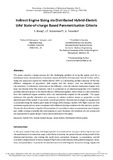- CERES Home
- →
- Cranfield Defence and Security
- →
- Staff publications (CDS)
- →
- View Item
JavaScript is disabled for your browser. Some features of this site may not work without it.
| dc.contributor.author | Wang, Siqi | |
| dc.contributor.author | Economou, John T. | |
| dc.contributor.author | Tsourdos, Antonios | |
| dc.date.accessioned | 2019-05-08T09:33:22Z | |
| dc.date.available | 2019-05-08T09:33:22Z | |
| dc.date.issued | 2019-04-28 | |
| dc.identifier.citation | Wang S, Economou JT, Tsourdos A. (2019) Indirect engine sizing via distributed hybrid-electric unmanned aerial vehicle state-of-charge-based parametrisation criteria. Proceedings of the Institution of Mechanical Engineers, Part G: Journal of Aerospace Engineering, Volume 233, Issue 14, 2019, pp. 5360-5368 | en_UK |
| dc.identifier.issn | 0954-4100 | |
| dc.identifier.uri | https://doi.org/10.1177/0954410019843722 | |
| dc.identifier.uri | http://dspace.lib.cranfield.ac.uk/handle/1826/14137 | |
| dc.description.abstract | This paper presents a design process for the challenging problem of sizing the engine pack for a Distributed Series Hybrid Electric Propulsion System (DSHEPS) of Unmanned Aircraft Vehicle (UAV). Sizing the propulsion system for hybrid electric UAVs is a demanding problem because of the two different categories of propulsion, (the engine and the motor), and the electrical system characteristics. Furthermore, what adds to the difficulty is that the Internal Combustion Engine (ICE) does not directly drive the propellers, but it is connected to an electrical generator and therefore provides electrical power to the Electric Motors (EM) and propellers. Hence there is a clear distinction from the traditional engine solutions which are mechanically coupled to the propeller. This paper addresses this specific distinction and proposes an indirect solution based on properties on the electrical part of the system. In particular, a novel parametric characterisation engine sizing approach is presented using the battery pack State-of-Charge (SOC) during a realistic UAV flight scenario. Five candidate engine options were considered with different starting conditions for the electrical system. The results show that by using the SOC properties it is possible to select an appropriate size of engine pack while carrying a suitable electrical propulsion pack. However, the solutions are not unique and are appropriate for given design criteria clearly indicated in the paper. | en_UK |
| dc.language.iso | en | en_UK |
| dc.publisher | SAGE Publications | en_UK |
| dc.rights | Attribution-NonCommercial 4.0 International | * |
| dc.rights.uri | http://creativecommons.org/licenses/by-nc/4.0/ | * |
| dc.subject | Hybrid UAV | en_UK |
| dc.subject | Hybrid System Design | en_UK |
| dc.subject | Series Hybrid | en_UK |
| dc.subject | Distributed Hybrid system | en_UK |
| dc.title | Indirect engine sizing via distributed hybrid-electric unmanned aerial vehicle state-of-charge-based parametrisation criteria | en_UK |
| dc.type | Article | en_UK |
Files in this item
The following license files are associated with this item:
This item appears in the following Collection(s)
-
Staff publications (CDS) [1209]

